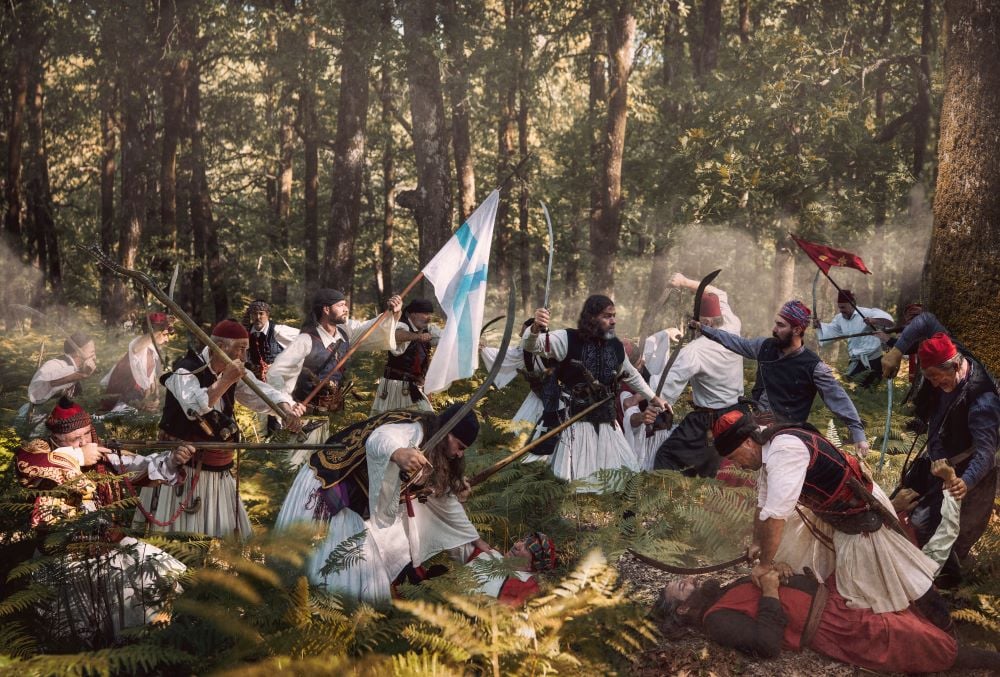
As Greece counts 203 years from the beginning of its War of independence, the mind travels back to the glorious days of 1821.
Those were times of bravery and battle, of blood and retaliation, rebels fighting against organized Ottoman armies, of total sacrifice and rebirth.
The new nation was conceived and born on the battlefield, nourished by the blood of its heroes, its ground a living monument of courage.
Watch our short documentary, narrated by Nasos Papargyropoulos and featuring unique photography by Elias Pergantis telling the quintessential story of Greece:
The heroes’ names echo through the decades, still inspiring awe, like the countless statues across the land, along with the battlegrounds:
Kolokotronis, Karaiskakis, Nikitaras, Androutsos, Diakos, Papaflessas, Kanaris, Bouboulina, Tombazis; Alamana, Dervenakia, Gravia, Missolonghi, Maniaki, Chios, Navarino.

Rigas Feraios, Filiki Eteria pioneers of Greek war of independence
It all started decades before 1821, when Rigas Feraios a writer and political theorist, a man who was active in the Modern Greek Enlightenment, killed an important Ottoman figure and fled to the mountains, at least according to the legend.
Feraios, whose real name was Antonios Rigas Velestinlis, may have fled Greece for a better future abroad as many young Greeks were doing at the time.
In any case, he formed the vanguard of the Greek War of Independence. His writings called on Greeks to rebel and fight for their freedom.
His epic poem “Thourios” contains a line that brings a tear to the eyes of Greeks, even today: ῾Καλύτερα μίας ώρας ελεύθερη ζωή παρά σαράντα χρόνια σκλαβιά και φυλακή.’
(“It is better live for one hour as a free man than forty years as a slave.”)
Feraios travelled in the Balkans, Italy and Austria in an attempt to drum up support for the Greek cause of liberation. Tragically, while in Austria he was betrayed and was later arrested and handed it over to the Ottomans.
He was then thrown into the Danube River to drown. His last words were: “I have sown a rich seed; the hour is coming when my country will reap its glorious fruits.” It was 1798.
Indeed, the seeds had been sown. In 1814, three like-minded Diaspora Greeks came together in Odessa, in present-day Ukraine, at that time home to a thriving Greek community.
The three men formed a secret society called the Filiki Eteria (The Society of Friends) with the decidedly “unfriendly” purpose of initiating an armed uprising to rid Greece of the Ottomans.
The three founders were Nikolaos Skoufas, from the province of Arta, Emmanuil Xanthos, from Patmos and Athanasios Tsakalov, from Ioannina.
The Filiki Eteria recruited mostly Phanariot Greeks from Russia, local chieftains from Greece, and Serbs into its ranks.
Two of its early outstanding members were Alexandros Ypsilantis, a prince and high-ranking officer of the Imperial Russian Cavalry, and Moldovan lord Michael Soutzos.
Future Greek War of Independence leaders such as Theodoros Kolokotronis, Odysseas Androutsos, Dimitris Plapoutas and the Metropolitan Germanos of Old Patras joined the effort as well.
In 1818, the Filiki Eteria moved to Constantinople, the year was marked by the death of founding member Skoufas. Xanthos and Tsakalov then tried to find a new leader to take over the reins.
Alexandros Ypsilantis became the head of the Filiki Eteria in April of 1820, starting preparations for the armed uprising immediately, setting up a military unit he named the Sacred Band.
Initially it was proposed to begin the revolution in Constantinople, but the idea was scrapped in favor of the Peloponnese (called the Moreas at that time).
The Filiki Eteria created a fund in which a large sum of money was deposited to meet the needs for arms, ammunition and supplies for the revolution.
They called on diaspora Greeks to contribute in any way they could to the war of liberation from the Ottomans. Ypsilantis sent fiery letters to all the centers of Hellenism across the world, asking them join in the fight.
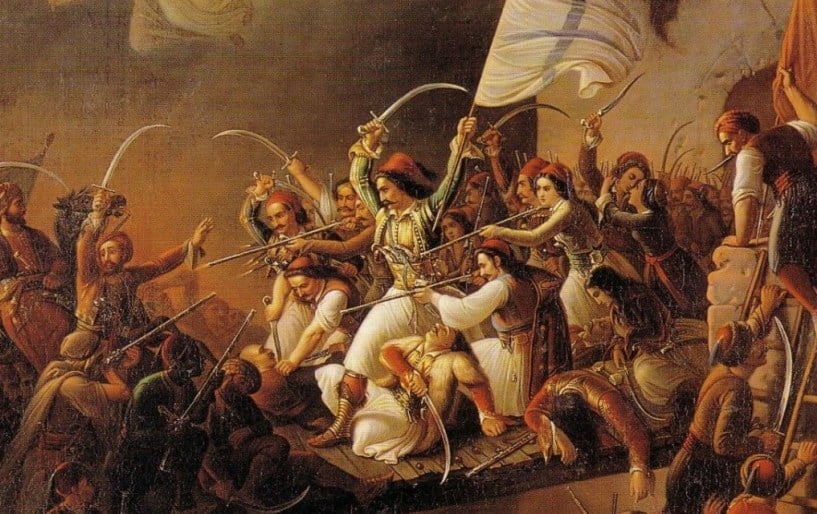
In October of 1820, Ypsilantis decided to begin the revolution in Moldova. He issued a declaration on 8 October 1820, announcing that he would soon be starting a revolt against the Ottoman Empire, which later would prove catastrophic because the Greek leader expected support that he never received.
The powers that Ypsilantis counted on — predominantly Russia — stayed clear of his ambitious campaign.
At the same time, the Ottomans were gathering a huge army and entered Moldova in order to suppress Ypsilantis’ nascent army and an uprising in Moldova.
The Turkish army met Ypsilanti’s men at Iasi. The Sacred Band and the army of volunteers were slaughtered in the Battle at Iasi.
Nevertheless, the revolutionary seed of the Filiki Eteria was planted, and the slogan “Liberty or Death” began to be uttered more and more on the lips of Greeks. The tide had turned.
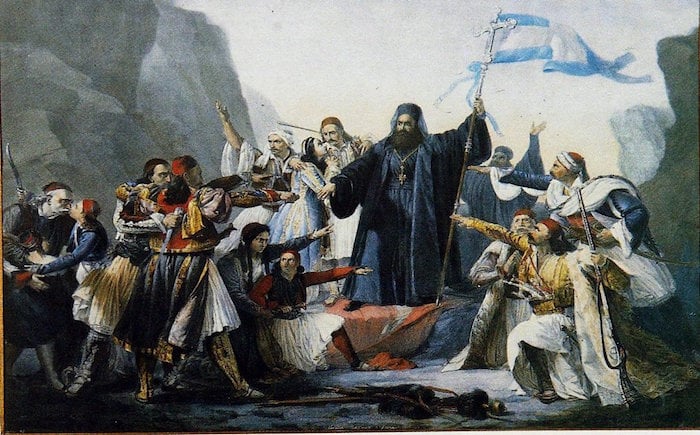
Agia Lavra Monastery: March 25, 1821
The defeat of Ypsilantis’ army in Moldova did not deter the eager Greeks in Moreas, however. They wanted to start the War of Independence as soon as humanly possible.
On March 13, 1821 Metropolitan Germanos of Old Patras (Palaion Patron Germanos) declared war at Agia Lavra Monastery, blessing the efforts of the freedom fighters.
March 13 is the day given by historians for this event. Yet Greeks chose March 25th as the historical day of the beginning of the war in earnest, so that the outbreak of the Revolution would coincide with the feast of the Annunciation of the Virgin Mary.
The Virgin Mary is the second-most sacred figure in the Greek Orthodox Church after Jesus Himself, and the choice of the day inextricably connects Orthodoxy with the Greek War of Independence.
When Palaion Patron Germanos raised the flag with the cross and blessed it, he signified that this was not only a war for freedom, but also a war of faith.
The slogan was “Liberty or Death” and the Greeks, who had been organizing their forces for months, went into the War of Independence with only that in mind.
Yet the very first flag of the revolution was actually raised on the island of Spetses on March 13 — by a woman. no less — Laskarina Bouboulina.
Bouboulina was a prominent shipowner on Spetses. Twice widowed with seven children, she was extremely wealthy, owning several vessels.
Once Spetses revolted against the Ottomans, the islands of Hydra and Psara followed suit. Between them, the islands had a fleet of over 300 ships to fight any naval battles that came their way.
The Greek heroine managed to capture the fortress at Monemvasia. She also took part in the blockade of Pylos and brought supplies to the revolutionaries by sea.
On March 17, the Maniots — descendants of the Spartans — declared war in Aeropolis and advanced to Kalamata with 2,000 men under their leader Petros Mavromichalis.
There, they joined forces with the troops of chieftains Theodoros Kolokotronis, Nikitaras and Papaflessas. Kalamata fell into Greek hands on March 23.
By the end of March, the rebelling Greeks controlled the whole countryside of the Moreas, while the Turks were confined to the forts in the cities.
The provincial capital of Moreas was Tripolitsa (today’s Tripolis), where many Muslims and their familes had fled.
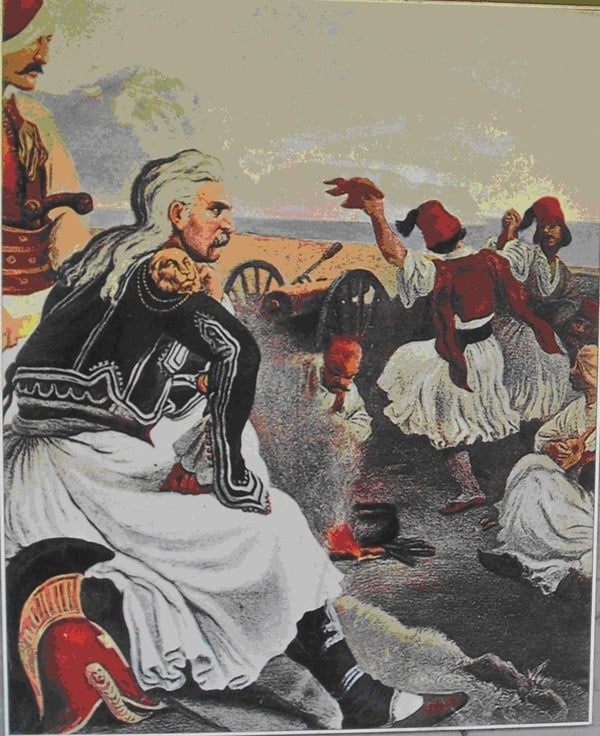
The Greeks, led by Theodoros Kolokotronis, besieged Tripolitsa for months. Finally, the city fell on September 23 and was unfortunately given over to the mob for two entire days.
By January of 1822 the entire Moreas region was liberated and became Greek territory once again.
The news that the Greeks had revolted naturally infuriated the Ottomans. In the seat of the Ottoman Empire, Constantinople, the Sultan ordered the massacre of the city’s Greek population in retaliation.
The Patriarch of the Greek Orthodox Church, Gregory V, was publicly hanged despite the fact that he had condemned the revolution and preached obedience to the Sultan.
Mass executions of Greeks took place along with an extensive pogrom, including the destruction of churches, and widespread looting of Greek properties.
The war of Independence in Central Greece
Central Greece joined the war, with Phocis and Salona being first, on March 24 and 27 respectively. Athanasios Diakos captured Livadeia on March 31 and Thebes two days later.
The revolutionaries moved south to Athens in mid-April and forced the Turks to fortify themselves in the Acropolis. The Greeks then laid siege to the holy mountain of the Acropolis.
At the time, Athens was populated by only about 10,000 people, half of whom were Christian Greeks and the other half were Muslims, being either Turks, Albanians or Greek Muslims.
The response of the Ottomans to the Central Greece revolt was to send Commander Omer Vrioni with his sizeable army to supress it and then, they hoped, move to Moreas to do the same.
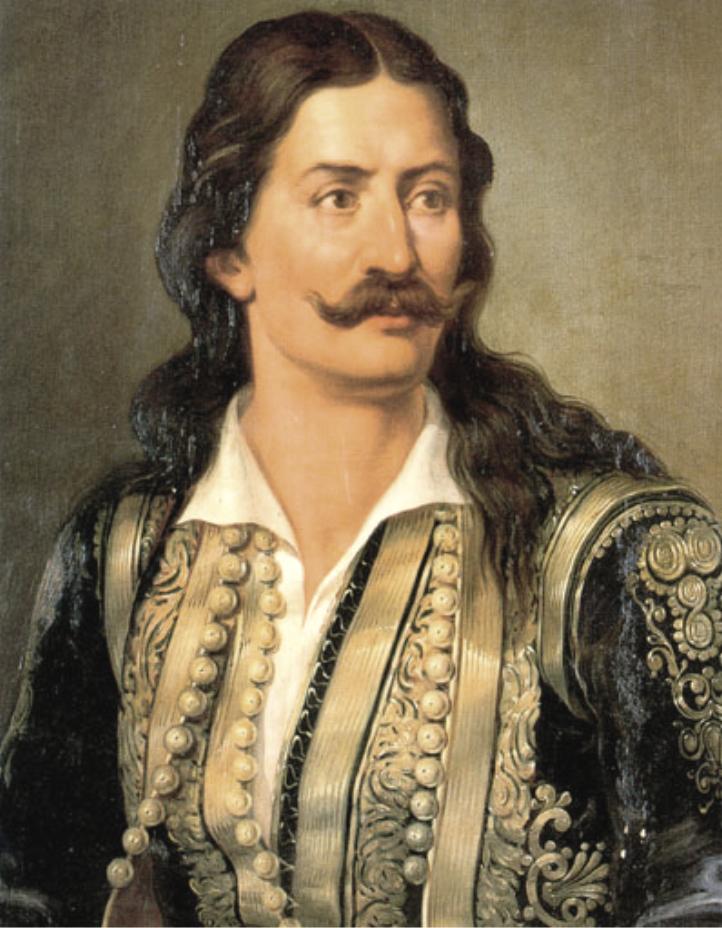
The army of Athanasios Diakos met with Omer Vrioni’s troops at Alamana on April 23, 1821. The outnumbered Greeks fought heroically, but tragically succumbed to the Ottoman forces.
Diakos was wounded and taken prisoner. He was then asked by Vrioni to denounce his Christian faith and collaborate with the Ottomans. Diakos naturally refused.
Diakos’ loyalty to Greece and devotion to his faith became legendary. His horrific punishment — death by impalement — became a symbol of Ottoman barbarism and brutality.
In Alamana, Greeks lost a great military leader. They also lost another battle at Eleftherohori. But thankfully, Vrioni’s army was not invincible.
The Greeks soon managed to halt the Ottoman advance at Gravia Inn under the leadership of Odysseas Androutsos.
When the Ottomans approached, they sent a messenger to demand the surrender of the rebelling Greeks.
Not only they did not surrender, but Androutsos shot the messenger dead, and along with his men they took cover at the Gravia Inn.
Forcing the Turkish Army to pass through a narrow passage where Gravia Inn was, Androutsos and his handful of men inflicted heavy casualties upon the enemy.
After the defeat, Vrioni postponed his advance towards Moreas while awaiting reinforcements. However, he invaded and captured Livadeia and was able to lift the siege of the Acropolis in Athens.
The Greeks then regrouped, and a force of 2,000 men managed to destroy a Turkish relief army on its way to Vrioni at Vassilika, forcing him to abandon Attica and retreat to Ioannina.
By the end of 1821, the revolutionaries had managed to temporarily secure their positions in Central Greece.

The provisional Constitution of 1822
The first day of 1822 was marked by the approval by vote of the first Constitution of the Revolution by the National Assembly of Epidaurus.
Better known as the “Provisional Polity of Greece,” it proclaims the nation’s decision for “political presence and independence.”
The text is influenced not only by the French Constitutions of 1793 and 1795, but also by the American Declaration of Independence of July 4, 1776 and the 1787 Constitution of the United States.
Members of an executive and a legislative body that were to govern the liberated territories were then appointed. Alexandros Mavrokordatos became president of the executive body.
Dimitrios Ypsilantis, who had called for the Assembly, was elected president of the legislative body.
However, in the regions of Greece that had not been liberated, the Ottomans retaliated against the rebels, while some islands were still reluctant to join the cause.
When Greeks from other islands landed on Chios and attacked the Turks in the citadel, the majority of its residents refused to participate.
The Ottomans responded vengefully to the killing of their soldiers and sent thousands of troops to the island.
The Chios Massacre was one of the darkest moments of the entire Greek War of Independence. The Turks slaughtered 42,000 residents and took 52,000 as slaves.
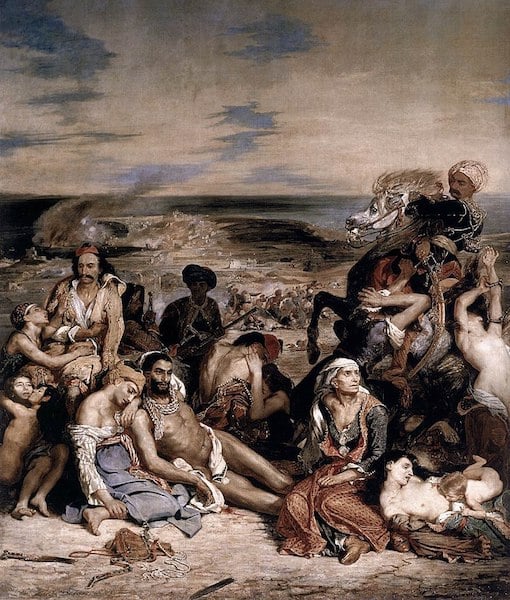
The massacre of thousands of Christians by the Ottoman hordes provoked international outrage and led to increasing support for the Greek cause worldwide.
Greeks could not allow for the Chios Massacre to pass and felt that they had to retaliate. On June 6, 1822 Admiral Constantinos Kanaris served justice in the best way possible.
As Turkish admiral Kara-Ali Pasha was holding a celebration on his flagship on Chios, Kanaris and his men approached with a fire boat and left it next to where the powder was stored on the ship.
All the Turks aboard the ship, including Kara-Ali Pasha, were instantly killed in the resulting explosion, with the fire spreading to the adjacent ships.
Several ships were destroyed, while the Ottoman casualties reached 2,000, including naval officers and seamen.
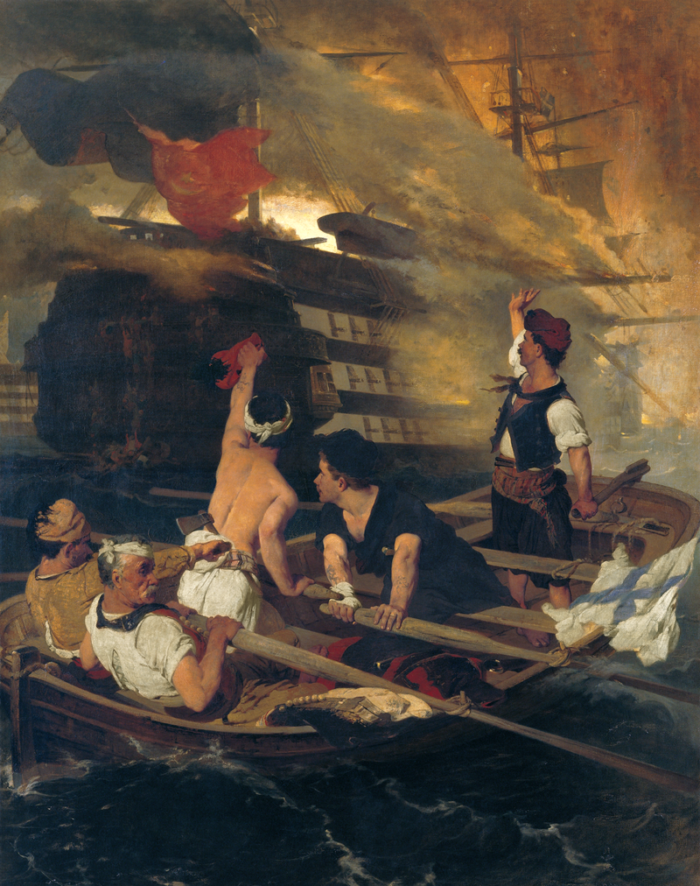
Philhellenes support the Greek War of Independence
The Chios Massacre brought international attention to the Greek struggle for liberation. From Europe to America, the scope of philhellenism grew wider as more and more academics and others became enamored of the Greek cause.
The English romantic poet Lord Byron was surely the best known philhellene of the time. Byron joined the Greek War of Independence actively and became a national hero for all Greeks, although he did not fall in battle.
Byron gave his life for Greece, dying in 1824 at the age of 36 from a fever contracted after the first and second siege of Missolonghi.

Inspired by Byron, American philhellene Dr. Samuel Gridley Howe sailed for Greece as soon as he earned his medical degree from Harvard University in 1824.
Howe, just 23 at the time, joined the Greek Army as a surgeon. His services, however, were not confined to surgery, because he fought in battles showing great bravery and skill in commanding troops.
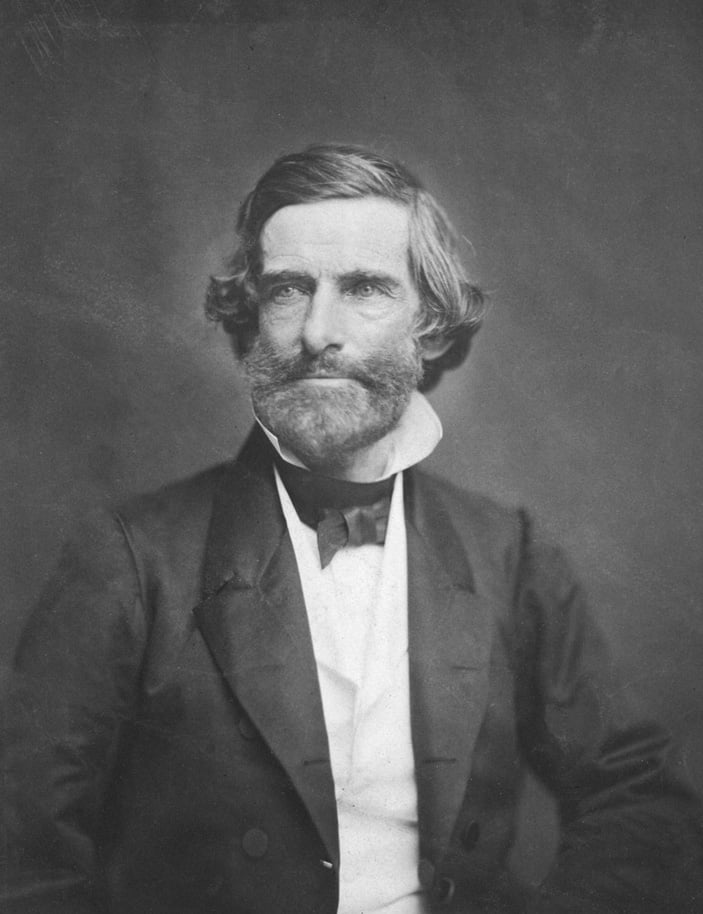
His enthusiasm and humanity soon won him the title “the Lafayette of the Greek Revolution.”
Even after returning to America in 1827 he engaged in campaigns to raise funds and supplies to help alleviate the desperate famine and widespread suffering in Greece, sending the equivalent of $16,000,000 in today’s money to the country.
Jonathan Peckham Miller, George Jarvis and George Wilson are three other great American philhellenes who were inspired to travel to Greece to fight in the war of liberation.
The Greek civil wars (1824-1825)
The momentum of the Greek uprising was such that by mid-1822 the whole of the Moreas and a big part of Central Greece were free.
The destruction of the Turkish Army at Dervenakia on July 26, 1822 sealed the Greek victory and recapture of a large part of the homeland — albeit temporarily.
The outcome of the victorious Battle at Dervenakia, also known as the Dramalis Massacre, was the destruction of a significant part of the Turkish Army.
Coming from Drama in the north of Greece to the Peloponnesian peninsula with 30,000 men, Dramalis (known as Drama Ali) wanted to take back Tripolitsa and Moreas.
The Turks took Corinth by storm and moved toward Argolis. Kolokotronis and his men were positioned in two of the four small mountain passes, called Dervenakia.
Trapped in the narrow passages, the Ottoman soldiers became the prey of the hidden Greeks. After the Ottomans counted 2,500-3,000 dead and wounded they were forced to retreat.
Unfortunately, solidarity between the victors was not as easily won.
Confident that they could govern the part of Greece that was free, the differences between military captains and politicians soon turned into conflict. The conflict had both political and regional dimensions, as the leaders of Central Greece (Roumeli) and island shipowners turned against the leaders of the Moreas.
The disputes led to a Second National Assembly that gathered in March 1823 in Astros. At that meeting, central governance was strengthened at the expense of regional bodies.
A new constitution was voted on, and new members were elected for the executive and legislative bodies.
Theodoros Kolokotronis and Petros Mavromichalis were elected to the executive body and Alexandros Mavrokordatos was elected president of the legislative body.
The first war started in March 1824, when the government asked Panos Kolokotronis to surrender the city of Nafplion. Panos refused and the government decided to besiege the city.
On March 22, 1824, the forces loyal to the new executive body besieged Tripolitsa, and after two weeks of fighting an agreement was reached between the two sides.
However, in the elections of October 1824, Peloponnesians who comprised the executive body took most of the government posts, shutting out their rivals.
New negotiations then began, but they led to armed conflict. Kolokotronis roused the residents of Tripolitsa against the local tax collectors of the government.
Papaflessas and Yannis Makriyannis failed to suppress the rebellion of the Kolokotronis followers, which spread throughout the Peloponnese.
Kolokotronis’ son, Panos, was killed by his opponents, and that devastated the great general, who could not overcome his son’s death and laid down his arms for a some time.
While the Peloponnesians were undecided about their further moves, the government regrouped its armies, which now consisted mainly of Roumeliots and Souliots.
The plan was to invade the Moreas and suppress Kolokotronis’ rebels. Roumeli chieftains like Georgios Karaiskakis, Kitsos Tzavelas and Ioannis Gouras led the campaign.
Kolokotronis was arrested and jailed and Mavrokordatos assumed the position of the President of the executive.
In May 1825, under the pressure of the Egyptian intervention, during the army of Ibrahim Pasha campaign, those imprisoned were released and granted amnesty.
During the civil war, on the mainland, where Greeks fought against other Greeks for petty political reasons, a major massacre took place on Psara Island.
The destruction of Psara on July 5, 1824, was one of the most moving tragedies of the entire Greek Revolution, as the the Ottomans decimated the civilian population of the island.
At the time, the entire population of Psara had been about 7,000 souls. After the massacre, the population of the island never rose over 1,000.
Second phase of the Greek war of Independence
While the Greeks were involved in their own war, the Ottomans started a major campaign to recapture the cities and countryside now governed by the revolutionaries.
On February 26, 1825, the Egyptian Army of Ibrahim Pasha landed undisturbed in Methoni, in the Moreas, with 4,000 infantry and 400 cavalry, and took over the city’s castle.
His plan was to take back the entire Peloponnesian peninsula from the Greeks. In the following days his men were reinforced with more troops.
The total number of Ibrahim’s infantry reached 15,000. By the end of April he had occupied the strategic castles of Koroni and Pylos (Neokastro).
On May 20, the Greek war hero Papaflessas decided to repulse the Egyptians himself. With a force of 3,000 Greeks, Papaflessas marched south to attack Ibrahim.
However, half of his troops deserted when they saw the massive Egyptian Army approach. Papaflessas then proclaimed an eloquent speech that shored up the morale of the remaining men.
The Greeks fought bravely and held their positions but were eventually overwhelmed. About 1,000 Greeks, including Papaflessas, fell that day.
Ibrahim ordered his men to recover the head and body of Papaflessas and place it upright on a post, as a mark of respect for a valiant foe.
Legend has it that Ibrahim kissed Papaflessas’ head and said “If all Greeks were like him, I would not take charge of this campaign.”
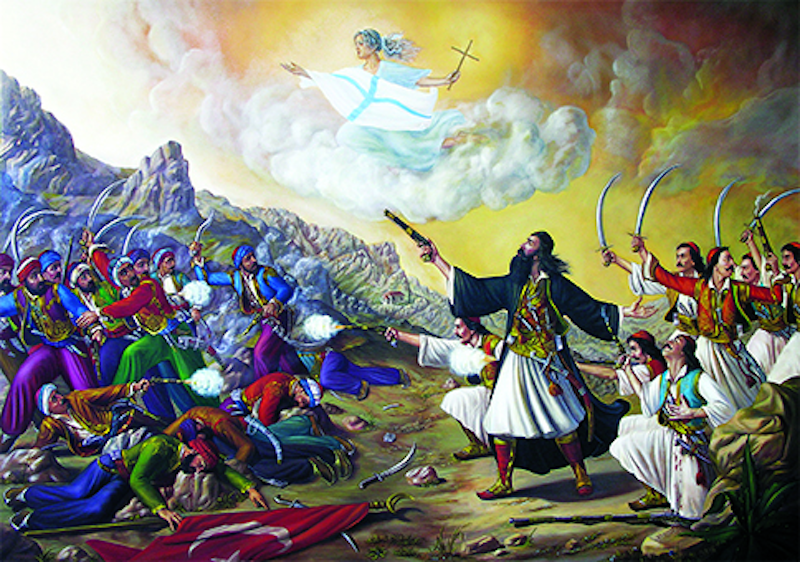
Ibrahim’s army advanced and on June 7 recaptured Tripolitsa, which had been abandoned by the Greeks.
Ibrahim Pasha then sent 5,000 troops to take over Nafplion, the seat of the Greek government.
On June 24, 1825 Greek forces of about 500 men, led by Captain Yannis Makriyannis and Demetrios Ypsilantis, met Ibrahim’s army at the Lerna Mills, a few miles from Nafplion.
It was a suicide mission — and Makriyannis acknowledged that fact. Yet he claimed that since God was on their side, they would win. If they died, it would be a good death, he added.
The outnumbered Greeks somehow defeated the Egyptian army. This, the first Greek success against Ibrahim, saved the city of Nafplion.

The heroic exodus and fall of Missolonghi
On April 1825, Reshid Mehmed Pasha received the following order from the Sultan: “Either Missolonghi falls or your head falls.” This meant the third siege of the western Greece city.
It was a difficult task to take over the fortified city, which was surrounded by lakes. The brave chieftains Notis Botsaris and Kitsos Tzavellas led the defense of Missolonghi.
The city was defended by about 3,000 men, with several philhellenes among them.
The siege lasted an entire year, with Ibrahim Pasha joining the attack after the first months. Yet what the vast Egyptian army could not achieve, starvation and disease did.
The defending captains decided to lead the starving civilians to a heroic exodus, while those who could not follow would stay and defend the city to the death.
When the Greeks charged heroically out of the city gates, they were fired upon by Turks and Egyptians.
Many panicked and fled back inside the walls, while the Turkish-Egyptian forces had already entered the city, killing, looting and raping.
Of the 7,000 people who attempted to escape, only 1,000 made it to safety. The rest were slaughtered or sold into slavery.
Many of the surviving Greek Christian women became sex slaves to Egyptian soldiers. In an especially grisly act, the Turks displayed 3,000 severed heads on the city walls.
Yet the Missolonghi massacre proved a victory for the Greek cause in the end, and the Ottomans paid dearly for their harsh treatment of Missolonghi.
After this atrocity, many Western Europeans felt increased sympathy for the Greek cause, while they were outraged against the barbaric Ottomans.
The horrific event influenced the eventual decision of Britain, France and Russia to intervene militarily in the Battle of Navarino one year later.
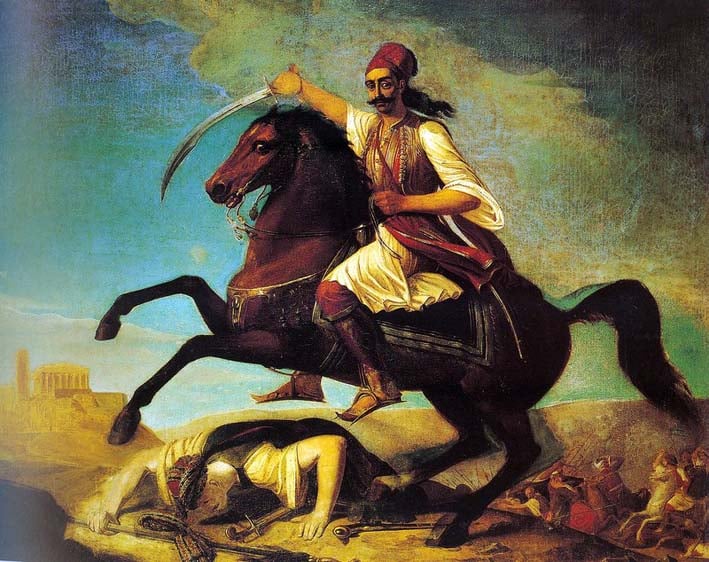
Karaiskakis beats the Turks in Central Greece
After the fall of Missolonghi the Turks continued their campaign to recapture the rest of Roumeli (Central Greece). Turkish troops under Mustafa Bey started their moves.
Upon receiving intelligence of the Ottoman Army’s maneuvers, Georgios Karaiskakis prepared a surprise attack near the village of Arachova.
On November 18, Mustafa Bey’s 2,000 troops were blockaded in Arachova by the Greek Army. An 800-man force which attempted to relieve the defenders three days later failed.
On November 22, Mustafa Bey was mortally wounded and Ottoman morale plunged, as cold weather and heavy rainfall plagued the hunger-stricken defenders.
At midday on November 24 the Ottomans made an attempt at breaking out. Most were killed in the fighting or perished from the cold.
The Greek victory at Arachova gained the rebels valuable time before the Great Powers came to their assistance one year later.
The Battle of Arachova brought the name of Georgios Karaiskakis to the forefront, making him one of the most well-known heroes of the Greek War of Independence.
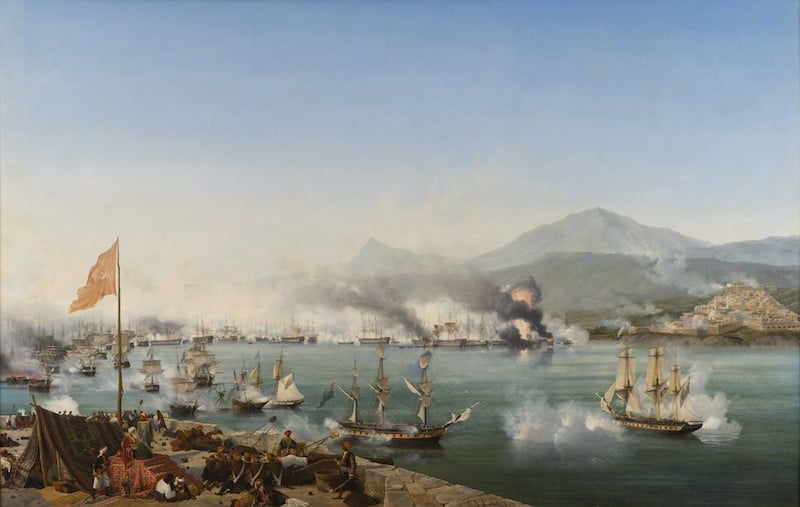
The Battle of Navarino
October 10, 1827 was a fateful day for Greek independence as British, French and Russian squadrons entered the harbor at Navarino Bay on the west coast of the Peloponnesian peninsula, in the Ionian Sea.
An Ottoman armada which, in addition to imperial warships, included squadrons from Egypt and Tunis, was destroyed by the Allied forces.
Virtually the entire Ottoman fleet was decimated, despite the fact that the Ottoman ships’ crews put up an extraordinary fight.
In another amazing turn, this was to be the last major naval battle in history to be fought entirely with sailing ships, although most ships fought at anchor.
The Allied naval forces essentially put an end to Turkish plans to recapture the parts of Greece they had lost after centuries of rule.
The casualties of the Ottomans were extremely high and morale was at the lowest point after that day.
Russia declares war on Turkey
The Greek War of Independence sparked the Russo-Turkish war that was long due, according to historians.
On April 26, 1826 the war broke out after Sultan Mahmud II closed the Dardanelles to Russian ships and revoked the 1826 Akkerman Convention.
The Turkish move was related to the Greek War of Independence because the closing of the Dardanelles was in retaliation for the Russian participation in the Battle of Navarino.
Greeks welcomed the war, of course, because the Ottoman troops would be leaving the newly-founded state to concentrate on the war against the Russians.

May 7, 1832: The Treaty of London establishes the state of Greece
The Treaty of London, signed by Britain, France and Russia, established a new Greek state, appointing Otto of Bavaria the King of Greece, defining Greece as an independent kingdom.
The Arta-Volos line was delineated as Greece’s northern frontier. The Ottoman Empire was indemnified in the sum of 40,000,000 piastres for the loss of their former territory.
The exact parameters of the Kingdom’s borders were confirmed again in the London Protocol of August 30, 1832, signed by the Great Powers, which ratified the border between Greece and the Ottoman Empire.
The London Treaty marked the formal end of the Greek War of Independence, creating modern Greece as an independent state, finally free of the Ottoman Empire.
See all the latest news from Greece and the world at Greekreporter.com. Contact our newsroom to report an update or send your story, photos and videos. Follow GR on Google News and subscribe here to our daily email!



